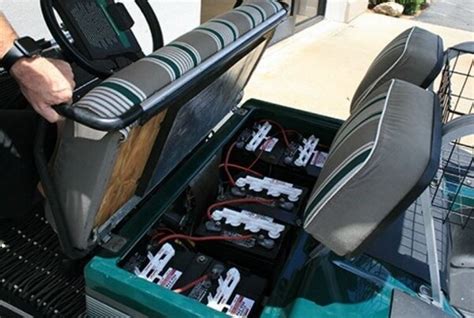The Definitive Guide to Golf Cart Battery Reconditioning
Golf cart batteries, while robust, eventually lose their punch. Before you shell out for a pricey replacement, consider reconditioning. This guide dives deep into the process, offering a comprehensive understanding of what it entails, its benefits, and how to do it safely and effectively. We'll cover everything from assessing your batteries to the maintenance needed to keep them running strong.
What is Golf Cart Battery Reconditioning?
Golf cart battery reconditioning is the process of restoring the capacity and performance of aging lead-acid batteries. It involves cleaning the battery terminals, equalizing the cells, and desulfating the plates. This isn't about a quick fix; it's about reversing the chemical degradation that leads to reduced performance and lifespan. Successful reconditioning can significantly extend the life of your batteries, saving you money in the long run.
Why Recondition Your Golf Cart Batteries?
There are several compelling reasons to consider reconditioning:
- Cost Savings: Replacing a set of golf cart batteries can be expensive. Reconditioning offers a significantly cheaper alternative.
- Environmental Friendliness: Disposing of old batteries isn't environmentally friendly. Reconditioning reduces waste and minimizes your environmental impact.
- Extended Lifespan: A properly reconditioned battery can provide many more months, even years, of reliable service.
- Improved Performance: Reconditioning can restore your batteries to near-original performance levels, leading to improved power and range.
How to Recondition Golf Cart Batteries: A Step-by-Step Guide
Safety First: Always wear safety glasses and gloves when working with batteries. Lead-acid batteries produce corrosive sulfuric acid, which can cause serious injury. Ensure adequate ventilation.
Step 1: Assessment and Preparation
- Inspect the Batteries: Carefully check each battery for physical damage, cracks, leaks, or corrosion on the terminals. Any severely damaged batteries are likely beyond reconditioning.
- Test the Batteries: Use a hydrometer to measure the specific gravity of the electrolyte in each cell. Low readings indicate sulfation. A battery load tester will assess the overall health and capacity.
- Clean the Terminals: Use a wire brush or terminal cleaner to remove corrosion from the battery terminals and connectors.
Step 2: Desulfation
Sulfation is a buildup of lead sulfate crystals on the battery plates, hindering their ability to accept and release charge. Several methods address this:
- Equalization Charging: This involves charging the batteries at a higher voltage for an extended period. This helps to break down the sulfate crystals. Caution: Over-equalization can damage the batteries. Follow the manufacturer's recommendations carefully.
- Pulse Charging: Specialized desulfation chargers use pulsed DC current to dislodge sulfate crystals. These are more effective but more expensive than conventional chargers.
- Battery Reconditioning Solutions: Some commercially available solutions claim to dissolve sulfate crystals. The effectiveness varies, and caution is advised. Always follow the product instructions precisely.
Step 3: Cleaning and Topping Off
- Clean the Battery Case: Wipe down the battery case with a damp cloth to remove any dirt or grime.
- Top Off with Distilled Water: Check the electrolyte level in each cell. If it's low, add distilled water to bring it up to the correct level. Never use tap water.
Step 4: Recharging and Testing
- Charge the Batteries: Use a suitable battery charger to fully charge the batteries. Monitor the charging process and follow the charger's instructions.
- Retest the Batteries: After charging, repeat the hydrometer and load tests to assess the effectiveness of the reconditioning.
Common Questions About Golf Cart Battery Reconditioning
How long does golf cart battery reconditioning take?
The time required varies depending on the method used and the condition of the batteries. Equalization charging can take several hours, while pulse charging might be quicker. Allow ample time for the process.
Can you recondition flooded golf cart batteries?
Yes, flooded lead-acid batteries are the most common type used in golf carts and are generally the easiest to recondition.
Can you recondition AGM golf cart batteries?
AGM (Absorbent Glass Mat) batteries are more challenging to recondition than flooded batteries. Their sealed design makes it difficult to access the cells for desulfation and equalization. While possible, it is more complex and requires specialized equipment.
How often should I recondition my golf cart batteries?
The frequency depends on usage, climate, and battery maintenance. Regular maintenance, such as keeping the terminals clean and regularly topping off the electrolyte (for flooded batteries), can significantly extend the time between reconditioning. As a general guideline, you might consider reconditioning every 1-2 years.
What are the signs that my golf cart batteries need reconditioning?
Several signs indicate that your golf cart batteries are losing their performance: reduced range, slower top speed, difficulty starting, and consistently low readings on a hydrometer test.
Conclusion
Reconditioning golf cart batteries can be a cost-effective and environmentally responsible way to extend their lifespan. While it requires some time and effort, the potential savings and benefits make it a worthwhile endeavor for many golf cart owners. Always prioritize safety and follow the instructions carefully to avoid damaging the batteries or causing injury. Remember, regular maintenance is key to maximizing the life of your golf cart batteries, whether reconditioned or new.

